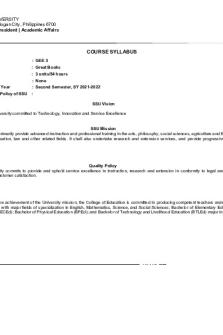WS1516 AICD Ex4 updated PDF

| Title | WS1516 AICD Ex4 updated |
|---|---|
| Course | Advanced Integrated Circuit Design (AICD) |
| Institution | Technische Universität Darmstadt |
| Pages | 5 |
| File Size | 217 KB |
| File Type | |
| Total Downloads | 89 |
| Total Views | 144 |
Summary
Übung 4...
Description
Analog Integrated Circuit Design Exercise 4 Integrated Electronic Systems Lab Prof. Dr.-Ing. Klaus Hofmann M.Sc. Katrin Hirmer, M.Sc. Sreekesh Lakshminarayanan
Status: 11:10:30
Pre-Assignments Please prepare the following exercises before the exercise session. The results will be needed during the lesson. In this exercise you will • get a deeper understanding of multistage amplifiers and the differences to differential amplifiers • analyze a differential amplifier to get a good understanding of its functioning
Exercise 4.1: Single Stage Amplifiers Recap the basic principles of differential amplifiers. a) What are the advantages of differential amplifiers compared to multistage amplifiers?
b) Which general circuit building blocks can you find in a two-stage opamp?
c) Which of the following statements is correct? If necessary, correct the answers. i. CMRR is the ratio of ACM to ADM ii. For a differential amplifier with ideal matched devices CMRR→∞ iii. The half circuit method can also be used for analyzing the input stage of operational amplifiers. iv. The half circuit method that we use for calculating the Q-point can also be used for the calculation of the differential mode gain.
AICD – Exercise 4 – Differential Amplifiers
1
d) What is the difference between Class-A, Class-B, and Class-AB output stages?
e) What is the purpose of the additional transistors that can often be found in output stages?
Exercise 4.2: Methodology Write down the different steps for half circuit analysis.
AICD – Exercise 4 – Differential Amplifiers
2
Exercise 4.3: Differential Amplifier The schematic of a differential amplifier with resistor load is given. You may assume the following parameters: VDD=12V, VSS=12V, I0=40µA RD=300kΩ, RG=1kΩ, RL=1kΩ, RSS=500kΩ, KN=KP=K=640µA/V2, VTN=-VTP=VT=1V, λN= λP= 0 Analyze the circuit according to the questions a)-c). Hint: Use the method of half circuit analysis.
a) Calculate the Q-points of the transistors M1 and M2. Hints: o Use the steps for DC analysis from preparation of Exercise 1. o Calculate Vds and Vgs. b) Calculate the differential mode gain ADM, the common mode gain ACM and the CMRR when using vo1 as output. Hints: o What does the symbol of current source mean for AC / DC? o ADM: AC Analysis → what happens to node at source of transistor? o Results: ADM=-24 =27.6dB; ACM=-0.3 =-10.5dB; CMRR=80=38.1dB c) Now vod is used for output. How does the result from b) changes?
AICD – Exercise 4 – Differential Amplifiers
3
Presence Exercises Exercise 4.4: Differential Amplifier Now the differential stage of Exercise 4.3 is extended by an output stage. Use the parameters as given in Exercise 4.3.
Answer the following questions: a) Calculate the Q-point of transistor M3. b) Calculate VQout. Hint: o During DC-Analysis you might find a quadratic equation. Solve it and check the meaningfulness of the two solutions by comparing them to the physical relationships given in the schematic. c) Calculate the Q-points of the transistors M4 and M5. Hint: o Which mode of operation are the transistors in? Linear region or saturation region? d) Calculate the differential mode gain ADM, the common mode gain ACM of the complete circuit. e) How does the CMRR change compared to b)? Interpret your results. Which part of the circuit is responsible for the common mode rejection?
AICD – Exercise 4 – Differential Amplifiers
4...
Similar Free PDFs

WS1516 AICD Ex4 updated
- 5 Pages

Ex4 - got good mark
- 1 Pages

Analysis 1 WS1516 Cheat Sheet
- 2 Pages

Analysis 1 WS1516 Übungsblätter
- 85 Pages

225F14Syllabus Updated
- 7 Pages

Updated Compact
- 2 Pages

UTS Instructional Material Updated
- 75 Pages

GEE3 BSED Syllabus Updated
- 6 Pages

Updated bio week 5
- 5 Pages

Morris PLAN Updated
- 4 Pages

Pascal.Nenzy Updated Resume
- 2 Pages
Popular Institutions
- Tinajero National High School - Annex
- Politeknik Caltex Riau
- Yokohama City University
- SGT University
- University of Al-Qadisiyah
- Divine Word College of Vigan
- Techniek College Rotterdam
- Universidade de Santiago
- Universiti Teknologi MARA Cawangan Johor Kampus Pasir Gudang
- Poltekkes Kemenkes Yogyakarta
- Baguio City National High School
- Colegio san marcos
- preparatoria uno
- Centro de Bachillerato Tecnológico Industrial y de Servicios No. 107
- Dalian Maritime University
- Quang Trung Secondary School
- Colegio Tecnológico en Informática
- Corporación Regional de Educación Superior
- Grupo CEDVA
- Dar Al Uloom University
- Centro de Estudios Preuniversitarios de la Universidad Nacional de Ingeniería
- 上智大学
- Aakash International School, Nuna Majara
- San Felipe Neri Catholic School
- Kang Chiao International School - New Taipei City
- Misamis Occidental National High School
- Institución Educativa Escuela Normal Juan Ladrilleros
- Kolehiyo ng Pantukan
- Batanes State College
- Instituto Continental
- Sekolah Menengah Kejuruan Kesehatan Kaltara (Tarakan)
- Colegio de La Inmaculada Concepcion - Cebu




